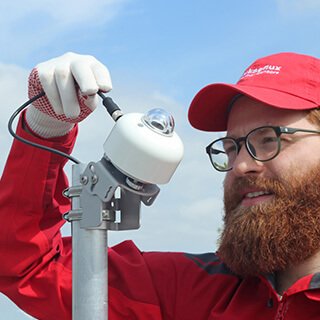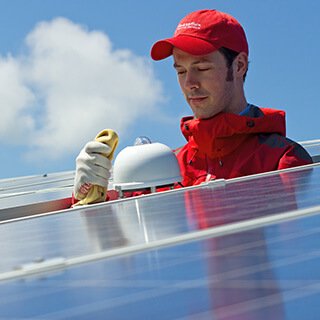Solar power monitoring: how to do that?
Solar power monitoring is the process of measuring the amount of solar irradiance that is received by your solar panels. If you want to measure the performance of your solar panels accurately, it is essential to use a solar power monitoring system.

In this article, we first dive deeper into the definition of solar power monitoring, and why monitoring is useful. Various methods are available to evaluate PV system performance and measure solar power. Finally, we conclude with the solar power meters we offer and how you can select the right one for your application.
What is solar power monitoring?
The monitoring of solar power involves tracking solar irradiance quantities. These quantities are essential for measuring the performance of your system.

Figure 1 shows such a system. The two solar power meters are installed to measure two critical solar power components. Let’s explore the components of solar radiation reaching your solar panels.
Different components of radiation
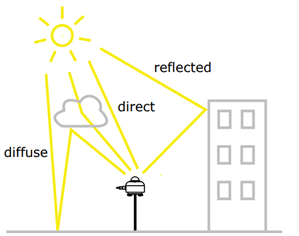
solar radiation reaching a solar power meter.
Solar radiation can be divided into multiple components characterised by how they reach a point. In Figure 2, those components and how they reach a solar power meter are schematically shown.
The radiation that falls directly on a point is called Direct Normal Irradiance (DNI). Indirectly, radiation can also reach the same point. This happens because surrounding objects, such as buildings or clouds, reflect, absorb, and emit the radiation. This component of radiation is called Diffuse Horizontal Irradiance (DHI). Combined, these two give the Global Horizontal Irradiance (GHI), a measurement of the total radiation.
The GHI is only relevant for horizontal surfaces, as is defined by the word ‘horizontal’ in GHI. However, solar panels are rarely mounted this way because they do not allow optimal use of the available solar power. The amount of DNI that reaches the panels during the day is optimised by placing them at an angle. Due to the shift in the angle, the GHI is no longer the most relevant variable. The total amount of radiation on a surface with the same angle is then defined by the Plane of Array (POA) irradiance, also called Global Tilted Irradiance (GTI). This, compared to the GHI, also consists of reflected irradiance from the ground.
Measurements of these components are crucial to check if your panels are generating the expected energy. This can be specified by calculating the Performance Ratio, which is explained in the next section.
Performance Ratio
The performance of the solar panels can be quantified by the Performance Ratio (PR). This ratio measures the output (Yf) versus the expected output (Yr) for a given period. To determine the expected output of a panel, you can refer to the manufacturer's specifications, which are usually provided on the panel's nameplate. The expected output is defined by what the PV module generates under STC (Standard Test Conditions: DNI of 1000 W/m2, air mass 1.5 spectrum, and a cell temperature of 25 °C). So, the PR is then defined as:
![]() , with
, with ![]() and
and ![]() .
.
Here, Eout is the AC energy delivered to the grid in kWh, and P0 is the rated capacity in kW defined under STC. Hi is the POA irradiance in kWh/m2, and Gi, ref is the reference irradiance under STC in kW/m2.
When calculating this PR metric, the effect of the module temperature is not considered. This means we can assess the influence of the temperature on the PR. At higher temperatures, the efficiency of the solar panels decreases, leading to lower Eout. This will be reflected by a lower PR. This can be useful when monitoring the seasonal effects on performance.
However, if we want to compare the PR of a warm summer day to a cold winter day without the influence of temperature, we need a temperature-corrected metric. This is achieved by changing the PR equation as follows:
![]() , with
, with ![]()
By using Tref = 25 °C, the PR'STC is obtained. This Ck term accounts for the difference between the actual temperature and the temperature of STC used for power rating. Further information on the calculation of these metrics can be found in our note: How to calculate PV performance ratio and performance index.
Now that we know how to calculate the performance, let’s explain why it is useful.
Why use a solar power monitoring system?
Monitoring solar power is crucial for optimising the yield of your solar farm. It allows you to compare your PV system's generated energy to the available solar power. This comparison gives insight into your system's performance ratio and efficiency, as explained in the previous section.
Measuring these things can enable the detection of (early) problems, which helps keep your system at its highest efficiency. During the design phase of your system, it is critical to have historical solar power data of the area where you are planning to build it. It not only allows you to have information on the potential energy yield, but it also assists you in deciding the optimal location, size, and tilt. Further information on why solar power monitoring is important, is available in our article: Solar energy meters: why use them in measuring solar energy?
Now, let us explain some methods to monitor solar power.
How to measure solar power?
There is a simple method for monitoring solar power for residential PV systems. This method relies on measuring your solar panels' voltage and current output. With this, the generated power in W and kWh is monitored. The owner of the solar panels has access to this data through a dashboard provided by the system installer. In Figure 3, such a system is schematically shown.
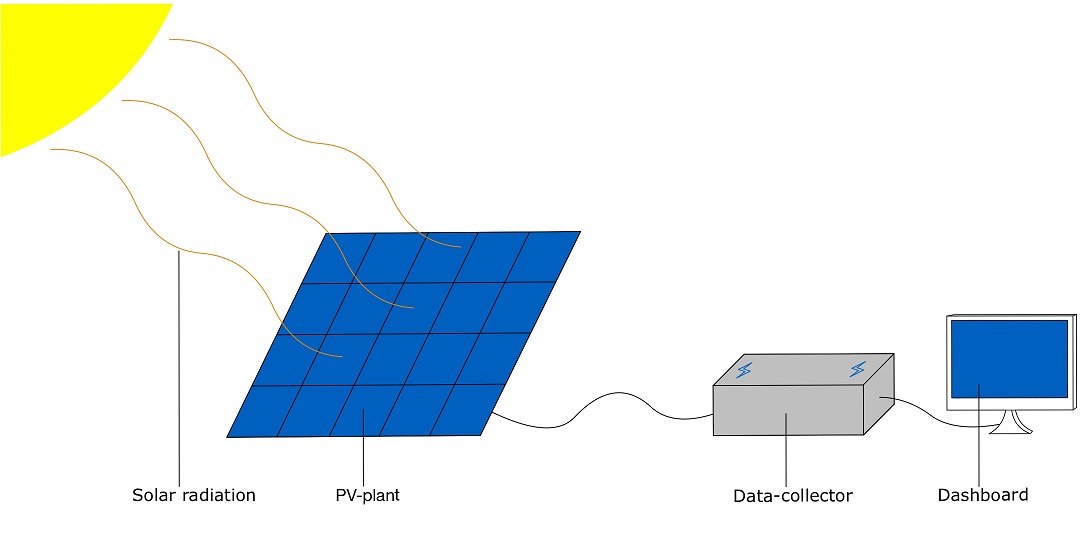
Such a system allows easy insight into the power generated by your solar panels. However, it cannot accurately assess whether it generates the expected amount of energy. For this, it needs more monitoring capabilities.
One possible solution is to compare the solar power generation of similar, neighbouring systems. This allows you to verify the system’s generated power. Suppose performance among neighbouring systems is different. In that case, a fault can be detected more confidently than when analysing only your panels.
Another way to verify the system's performance is to compare it to satellite-based irradiation estimates. However, this method is limited by the resolution and accuracy of the model used by the satellite organisation and is associated with significant short-term inaccuracies.
An advantage of these methods is that no additional measurement equipment is necessary, which means no extra costs need to be made. So, this is an efficient way of measuring performance for residential systems. The main limitation of these methods is that none actually measures the solar power reaching your panels. As seen from the PR equations, we need such a measurement of the POA irradiance to calculate the PR. This calculation is desired for larger-scale applications such as solar farms. So, how to measure solar power for these applications?
Solar power meters
The most accurate solar power measurements at solar farms are obtained using pyranometers and pyrheliometers. Pyranometers can measure incoming irradiance with a 180 ° view. So, when mounted horizontally, they measure all irradiance coming in from above, which is the GHI. If the pyranometer is mounted at an angle, it measures the POA irradiance. When a shadow ring is used, which blocks irradiance from directly reaching the sensor, the DHI is measured. The pyrheliometers, however, only have a 5 ° view and can measure the DNI when combined with a tracker that follows the sun's position.
Due to their price, pyranometers are unsuitable for smaller-scale PV systems and residential use. However, a monitoring system including these solar power meters is necessary for larger-scale solar farms to maintain a high-quality system.
The following section explains what kind of pyranometers we offer and how to use them to achieve the highest monitoring standard.
Our solar power meters
Hukseflux is the leading manufacturer of pyranometers, both in technology and market share. We offer several solar power meters to help create your solar power monitoring system. Depending on the application and accuracy that is required, different sensors are best suited to gather your data.
IEC 61724-1:2021 standard
The IEC 617214-1:2021 sets the PV system performance monitoring standard and can be split into two accuracy classes. Read more on this topic in our article: The IEC 61724-1:2021 standard for PV monitoring systems: a quick explanation. This standard determines what hardware to use, quality checks, and measurement procedures. The requirements for solar radiation measurements are as follows:
Table 1 Requirements for solar radiation measurement in the IEC 61724-1 monitoring classification system.
| CLASS A | CLASS B | |
| Irradiance measurement | for GHI and POA: pyranometer Spectrally flat Class A (secondary standard) or for POA only: matched high-accuracy PV reference cell (same cell type and anti-reflection coating as the PV system) For reflected irradiance, Class C pyranometers or PV reference cells may be employed | POA measurement and panel temperature measurement are required GHI and other parameters may be derived by other means than on-site measurements, such as satellite observation |
| Dew and frost mitigation | Required, except for locations where dew and frost are expected for less than 2 % of annual GHI hours. Whether an installation site requires mitigation is decided by analysis of typical meteorological year data for the site. Dew or frost is considered expected when ambient temperature is within 1.5 °C of dew point | not required |
| Cleaning | 1 x / week (unless it can be proven that this is not needed) | not required |
| Alignment | tilt ± 1 ° azimuth ± 2 ° | not required |
| Quality checks | calibration prior to use calibration 1 x / 2 yr | calibration prior to use calibration schedule as recommended by manufacturer |
| Number of systems per PV power plant | minimum recommended number depends on system size | minimum recommended number depends on system size |
As seen from Table 1, for a system to belong to Class A, it has to follow stricter rules than Class B. Class A has higher accuracy and is necessary for utility-scale and large commercial PV systems. For rooftop or small to medium-sized commercial systems, the medium accuracy of class B is needed.
Detailed information can be found in our pyranometer selection guide to help decide which accuracy class is necessary for your application.
Class A pyranometer
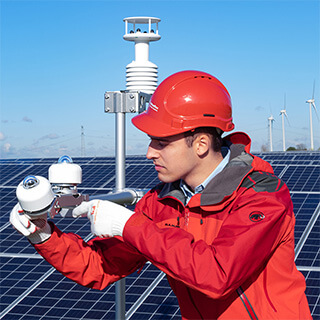
output for GHI (Global Horizontal Irradiance) and POA
(Plane of Array) measurement applications.
If the goal is to create a system that satisfies the highest standard of accuracy set by Class A, we offer the SR30. This pyranometer, released by Hukseflux in January 2017, was the first sensor to comply with the Class A standard in its standard configuration. The SR30 can heat the outer dome of the sensor without the need for an external system to perform the ventilation. This built-in heating and ventilation system mitigates dew and frost, ensuring high data availability and is much more power-efficient than traditional ventilation systems. For more information on this pyranometer, read Solar radiation sensors: become an expert on pyranometers.
Our SR20 series can also comply with the Class A standard when combined with the VU01 ventilation unit. The SR20 – without an external ventilation unit – can also satisfy the Class A standard if dew and frost are expected for less than 2 % of annual GHI hours.
For Class A, both GHI and POA irradiance measurements can be necessary. As explained earlier in this article, the Plane of Array (POA) irradiance measures the total amount of radiation on a tilted plane. Our solar power meters can measure this by mounting them at an angle. One of our mounting fixtures, such as the PMF01, can achieve this. Figure 4 shows a setup using the SR30 to measure the GHI and POA irradiance.
Class B pyranometer
For a Class B compliant monitoring system, only on-site measurement of POA irradiance is required. This can be achieved by mounting the SR20, SR15, or SR05 at an angle using one of our tilt mounts. These pyranometers satisfy the accuracy standards of class B. With this, the irradiance measurement requirements are fulfilled.
Conclusion
A solar power monitoring system measures the solar irradiance reaching your panels. The two most essential irradiance components are Global Horizontal Irradiance (GHI) and Plane of Array (POA). These measurements are performed by solar power meters called pyranometers or pyrheliometers. Monitoring GHI and POA irradiance allows you to gain crucial insight into the performance of your PV system, detect problems, and tackle them. Depending on the application scale, several methods to monitor the performance are summarised in the following table.
| Application scale | Method | Accuracy |
| Residential systems | Measuring the generated power of solar panels in W and kWh | Low |
| Rooftop or small to medium-sized commercial systems (IEC 61724-1, Class B) | POA irradiance measurement in W/m2 from a pyranometer | Medium |
| Utility-scale and large commercial systems (IEC61724-1, Class A) | POA and GHI irradiance measurements in W/m2 from two pyranometers | High |
If you need more information about solar radiation measurements or our products, do not hesitate to contact us.








